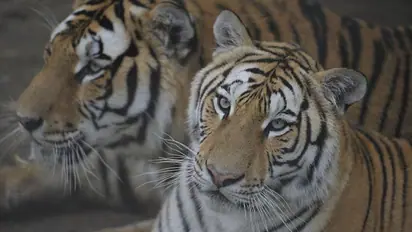Diplomacy in conservation: India to translocate tigers to Cambodia, eyes collaboration with Kazakhstan

Synopsis
As early as 2016, Cambodia expressed its desire to reintroduce tigers, initiating talks with countries like India, Thailand, and Malaysia. Nevertheless, wildlife experts insisted that addressing the root causes of extinction must precede any reintroduction efforts.
India is embarking on a significant initiative to relocate tigers to Cambodia, with the aim of revitalizing the big cat population in the region. Concurrently, discussions between India and Kazakhstan are underway regarding the potential translocation of tigers. This move follows the successful translocation of African Cheetahs to India, prompting the government to consider sending tigers to Cambodia, where the species has become extinct.
The collaboration stems from a Memorandum of Understanding (MoU) signed between India and Cambodia in November 2022, with a commitment to providing technical expertise for the tiger reintroduction.
Tamil Nadu BJP wishes CM MK Stalin on his birthday in Mandarin amid ISRO advertisement row
Tigers in Cambodia faced extinction due to a destructive combination of habitat loss and poaching. The felling of forests for developmental activities, coupled with the encroachment of human settlements into these areas, subjected the tiger's habitat to stress.
Shrinking habitats resulted in heightened competition for prey, increased inbreeding, and elevated human-animal conflicts.
The illegal trade in tiger parts, driven by persistent demand, further exacerbated the crisis. Every part of the tiger, from whisker to tail, found its way into illegal wildlife markets, where bones were used for health tonics, and skins became status symbols.
The last camera-trapped sighting of a tiger in Cambodia dates back to 2007, and by April 2016, Cambodia declared tigers "functionally extinct," signifying the absence of breeding populations in the country.
As early as 2016, Cambodia expressed its desire to reintroduce tigers, initiating talks with countries like India, Thailand, and Malaysia. Nevertheless, wildlife experts insisted that addressing the root causes of extinction must precede any reintroduction efforts.
Cambodia has since focused on creating a more hospitable environment for tigers, striving to rectify the issues that led to their disappearance.
BJP may field PM Modi from a second seat in South India; Ramanathapuram in TN under consideration
Comprising thirteen nations, including India, Bangladesh, and China, the global tiger range set a goal in 2010 to double tiger populations by 2022. India surpassed this objective ahead of schedule, currently harboring over 70% of the world's wild tiger population, numbering around 3,000. Notably, Laos and Vietnam have witnessed the extinction of this majestic species, emphasizing the urgency and importance of international conservation efforts.
Stay updated with the Breaking News Today and Latest News from across India and around the world. Get real-time updates, in-depth analysis, and comprehensive coverage of India News, World News, Indian Defence News, Kerala News, and Karnataka News. From politics to current affairs, follow every major story as it unfolds. Get real-time updates from IMD on major cities weather forecasts, including Rain alerts, Cyclone warnings, and temperature trends. Download the Asianet News Official App from the Android Play Store and iPhone App Store for accurate and timely news updates anytime, anywhere.